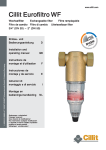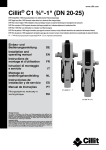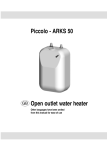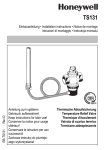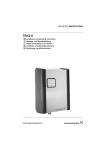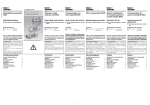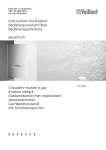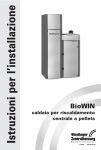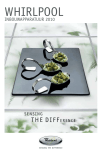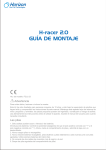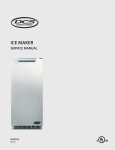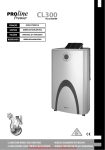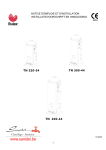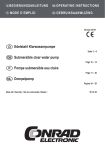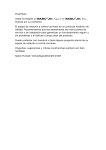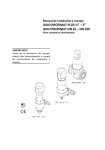Download BWT Celsius 80.p65
Transcript
Einbau- und Bedienungsanleitung D Installation and operating manual GB Instructions de montage et d'utilisation F Instrucciones de montaje y de servicio E Istruzioni di montaggio e di servizio I Montage en bedienings-handleiding NL 1 - 505847 / 8873 / 6.01 / © BWT Wassertechnik GmbH / Printed in Germany BWT Celsius 80 Heisswasserfilter Hot water filter Filtre d’eau chaude Filtro para agua caliente Filtro per acqua calda Heetwaterfilter 3/4" (DN 20) – 2" (DN 50) Änderungen vorbehalten! Changes res erved! Sous réserve de modifications! Nos reservamos cualquier modificación! La Società si reserva il diritto di qualsiasi modifica ai propri prodotti! Wijzigingen voorbehouden! B E S T WAT E R T E C H N O L O G Y Vielen Dank für das Vertrauen, das Sie uns durch den Kauf eines BWT-Gerätes entgegengebracht haben. D Seite 4 Thank you very much for the confidence that you have shown in us by purchasing a BWT appliance. GB Page 7 Nous vous remercions de la confiance dont vous nous témoignez par l’achat d’un appareil BWT. F Page 10 Muchas gracias por la confianza depositada en nosotros al comprar un equipo BWT. E Página 13 Vi ringraziamo per la fiducia accordataci acquistando un’apparecchiatura BWT. I Pagina 16 Hartelijk dank voor het vertrouwen dat u in ons gesteld hebt door uw aankoop van een BWT-apparaat. 2 NL Page 19 2 1 2 A B C 3 D 4 5 E F G 3 D Lieferumfang Funktion BWT Celsius 80 komplett, bestehend aus: 1 Kopfteil 2 Anschlussverschraubungen mit Dichtung 3 Filterunterteil 4 Entleerungsventil 5 Filterelement (für DN 3/4 - 1 1/4" und 1 1/2" - 2") Das Rohwasser strömt durch den Rohwassereingang in den Filter und dort von aussen nach innen durch das Filterelement zum Reinwasserausgang. Dabei werden Fremdpartikel grösser 90 µm an der Aussenseite des Filtergewebes zurückgehalten. Sauberes Wasser gelangt in das Rohrleitungsnetz. Sicherheitshinweis Einbauvorbedingungen Gefahr Vor Filterwechsel, Reparatur- und Wartungsarbeiten die Absperrhähne vor und hinter dem Filter schliessen und den Filter abkühlen lassen. Verwendungszweck Die Filter sind zur Filtration von Trink- und Brauchwasser bis 80 °Celsius bestimmt. Sie schützen die Wasserleitungen und die daran angeschlossenen wasserführenden Systemteile vor Funktionsstörungen und Korrosionsschäden durch Fremdpartikel wie Rostteilchen, Späne, Sand, Hanf etc. Die Filter sind auch einsetzbar für die Filtration von Prozesswasser und Kühlwasser für Durchlaufkühlungen, jedoch nicht bei chemikalienbehandelten Kreislaufwässern. Für Öle, Fette, Lösungsmittel, Seifen und sonstige schmierende Medien sind die Filter nicht geeignet. Ebenso nicht zur Abscheidung wasserlöslicher Stoffe. Achtung: Die Einrichtung der Anlage muss entsprechend der Einbau- und Bedienungsanleitung It. der AVB Wasser V, § 12.2 durch das Wasserversorgungsunternehmen oder ein, in ein Installateurverzeichnis eines Wasserversorgungsunternehmens, eingetragenes Installationsunternehmen erfolgen. 4 Örtliche Installationsvorschriften, allgemeine Richtlinien und technische Daten beachten. Filter gemäss der Nennweite in gleichdimensionierte Wasserleitungen und vor den zu schützenden Objekten einbauen. Dabei grundsätzlich Absperrventile vorsehen. Einbau waagerecht in die Wasserleitung vornehmen (Fliessrichtungspfeile beachten). Senkrechter Einbau hat keine Auswirkung auf die Funktion. Achtung: Der Einbauort muss frostsicher sein und störende Einflüsse vermeiden (z.B. Lösungsmitteldämpfe, Heizöl, Waschlaugen, Chemikalien aller Art). Einbau Siehe Einbauschema. Filter und Absperrventile vor und nach dem Filter in die Wasserleitung einbauen (Fliessrichtungspfeil auf dem Kopfteil beachten). Inbetriebnahme Filter auf ordnungsgemässe Installation prüfen. Die Absperrventile dürfen noch nicht geöffnet sein. Filterunterteil (3) auf richtigen Sitz prüfen und Entleerungsventil (4) schliessen. Dabei darf kein Werkzeug verwendet werden. Handfestes Anziehen genügt. Absperrventile vor und nach dem Filter langsam öffnen und die Rohrleitung an der nächsten Entnahmestelle nach dem Filter entlüften. Bedienung Filter in regelmässigen Abständen, alle 2 Monate inspizieren (gem. DIN 1988). Wasser ist ein Lebensmittel. Beim Filterwechsel hygienische Sorgfalt wahren! Filterelement wechseln Wenn infolge zunehmender Verschmutzung des Filtergewebes der Wasserdruck spürbar nachlässt, spätestens jedoch alle 6 Monate (gem. DIN 1988) muss das Filterelement gewechselt werden. A Absperrventile vor und nach dem Filter schliessen, Fliter abkühlen lassen und ein Auffanggefäss unter den Filter stellen. Entleerungsventil (4) zur Druckentlastung aufdrehen und Wasser ablaufen lassen. B Filterunterteil (3) von Hand abschrauben (Kein Werkzeug!), Filterelement (5) herausnehmen und zum Recycling geben. G Absperrventile erst vor und dann nach dem Filter langsam öffnen, Filter auf Dichtheit prüfen (Sichtprüfung) und die Rohrleitung an der nächsten Entnahmestelle nach dem Filter entlüften. Wartung Jede technische Anlage bedarf einer regelmässigen Wartung. Gemäss DIN 1988 muss diese grundsätzlich durch Fachpersonal erfolgen, das auch den Austausch der Verschleissteile vornimmt. Wir empfehlen den Abschluss eines Wartungsver trages. Die Wartung muss 1 x jährlich, bei Gemeinschaftsanlagen 2 x jährlich erfolgen. Durchführung: Installateur oder Hersteller. Gewährleistung Im Störfall während der Garantiezeit (bei Vorliegen eines Wartungsvertrages = 2 Jahre, sonst 6 Monate) wenden Sie sich bitte unter Nennung des Gerätetyps und der PNR = Produktions-Nummer (s. technische Daten bzw. Typenschild des Gerätes) an unseren Werkskundendienst. Gewährleistungsarbeiten dürfen nur vom Werkskundendienst ausgeführt werden. Gewährleistungsarbeiten durch eine Fachfirma bedürfen des ausdrücklichen Auftrages unserer Kundendienstleitung. Filterunterteil reinigen, Dichtung überprüfen und gegebenenfalls erneuern. C Neues Filterelement nur mit Beutel anfassen. Beutel am Einsteckende des Filterelement öffnen. D Filterelement (5) in das Kopfteil (1) stecken. E Beutel abziehen. Filterelement nicht mehr mit der Hand berühren. F Filterunterteil (3) wieder handfest in das Kopfteil (1) einschrauben. Entleerungsventil(4) zudrehen. 5 D D Technische Daten Typ 3/4" 1" 1 1/4" 1 1/2" 2" DN 20 25 32 40 50 Durchflussleistung bei Dp = 0,2 bar m3/h 3,0 3,5 4,0 9,0 12,0 BWT Celsius 80 Anschlussnennweite Durchlassweite, untere / obere µm 90 / 110 Nenndruck (PN) bar 10 Wassertemperatur °C 80 Umgebungstemperatur max. °C 40 Baulänge ohne Verschraubung A mm 100 100 105 140 140 Baulänge mit Verschraubung B mm 184 184 203 254 274 Gesamthöhe C mm 242 242 242 300 300 Mindestabstand Rohrmitte bis Boden D mm 350 350 350 450 450 Gewinde Überwurfmutter G G1 Mindestabstand Rohrmitte bis Wand mm Betriebsgewicht, ca. kg PNR ( = Produktionsnummer) 1/4" G1 1/4" G1 G2 1/4" G 2 1/4" 50 50 50 60 60 2,5 2,5 2,7 5,8 6,1 7-810063 7-810064 7-810065 6-085012 6-085013 B A D C G 6 1/2" Scope of supply Installation conditions Complete BWT Celsius 80 filter consisting of: 1 Top section 2 Connection fittings with seals 3 Brass cylinder 4 drain valve 5 Filter element (for DN 3/4 - 1 1/4" and 1 1/2" - 2") Observe the local installation regulations, general guidelines and the technical specifications. Application Install the filter according to its nominal width in water pipes of the same dimensions and before the equipment to be protected. Always provide stop valves. Install the filter in a horizontal position in the water pipe (observe flow direction arrows). A vertical installation does not affect the function. This filter is intended for the filtration of drinking and service water up to 80° C. It protects the water pipes and the connected water system parts from malfunctions and corrosion damage due to impurities such as rust particles, chippings, sand, hemp, etc. Attention: The installation site must be protected against frost and must ensure the protection of the filter against e.g. solvent vapours, fuel oil, lees, chemicals of any kind. The filter can also be used for the filtration of process water and cooling water for continuous cooling systems, but not in applications with chemically treated circulating water. Installation The filter is not suitable for oils, greases, solvents, soaps and other lubricating media nor for the separation of water-soluble substances. See installation drawing on the left. Install the filter and the stop valve in flow direction in the water pipe (see flow direction arrows on top section). Attention: In accordance with AVB Wasser V, § 12.2, the installation of the equipment may only be carried out by the public water supply company or by an installation company listed in the installer directory of a water supply company. Function The untreated water flows through the untreated water inlet into the filter and from there from the inside to the outside through the filter element into the clean water outlet. Any impurities >90 µm are trapped on the inside of the filter cloth and clean water is fed into the piping system. 7 GB GB Startup Maintenance Check the filter for proper installation. The stop valves must not yet be opened. Check the brass cylinder (3) for proper fit and close the drain valve (4). Please do not use tools. Manual fastening of the screw is sufficient. All technical equipment requires regular maintenance. According to DIN 1988, maintenance must be carried out by expert technical staff who also replaces the parts subject to wear and tear. We therefore recommend closing a maintenance contract. Slowly open the stop valves before and after the filter and deaerate the pipework at the bleeding point closest to the filter (after the filter). Maintenance must be carried out once a year, or twice a year for communal installations. It is to be carried out by the installer or manufacturer. Operation Warranty The filter must be checked at regular intervals, i.e. every two months (according to DIN 1988). In the event of malfunction during the warranty period (2 years with a maintenance contract, 6 months in other cases) please contact our Customer Service and state the filter type and the production number (see Specifications or rating plate). Water is a consumable liquid. When exchanging the filter, proper hygiene must be ensured. Exchanging the filter element The filter element must be replaced if due to increasing dirt accumulation on the filter cloth there is a noticeable drop of the water pressure, or after 6 months at the latest (according to DIN 1988). A Close the stop valves before and after the filter and provide a collecting basin under the filter. Open drain valve (4) for pressure relief and empty the filter. B Open brass cylinder (3) manually (no tools!), remove filter element (5) and dispose of it. Clean the brass cylinder. C Leave the plastic bag on the new filter element when holding it. Open the bag at the insertion end of the filter element. D Insert the filter element (5) into the top section (1). E Remove the plastic bag. Make sure not to touch the filter element with your hand. F Screw the brass cylinder (3) into the top section (1) and fasten it manually. Close the disdrain valve (4). G Slowly open the stop valves, first those before, then those after the filter. Check the filter for proper sealing (visual inspection) and then deaerate the pipe at the bleeding point closest to the filter (after the filter). 8 Any warranty work may only be carried out by our Customer Service. Warranty work to be carried out by an external specialist firm requires the express consent of our Customer Service Manager. Specifications BWT Celsius 80 Type Nominal connection width DN Throughput at Dp = 0,2 bar 3 m /h 3 /4" 1" 11/4" 11/2" 2" 20 25 32 40 50 3,0 3,5 4,0 9,0 12,0 Lower/upper admission width µm 90/110 Nominal pressure (PN) bar 10 Water temperature °C 80 Ambient temperature max. °C 40 GB Overall length without fitting A mm 100 100 105 140 140 Overall length with fitting B mm 184 184 203 254 274 Total height C mm 242 242 242 300 300 Minimum distance pipe centre to floor D mm 350 350 350 450 450 G 1 1/4" G 1 1/4" G 1 1/2" G 2 1/4" G 2 1/4" mm 50 50 50 60 60 kg 2,5 2,5 2,7 5,8 6,1 7-810063 7-810064 7-810065 6-085012 6-085013 Swivel nut thread G Minimum distance pipe centre to wall Operating weight, approx. PNR (= production number) B A D C G 9 Etendue de la livraison F La fourniture complète BWT Celsius 80 comprend: 1 tête du filtre 2 raccordement avec les joints 3 partie inférieure du filtre 4 purge 5 élément filtrant (pour DN 3/4 - 1 1/4" et 1 1/2" - 2") Utilisation Les filtres sont destinés à la filtration d'eau potable et industrielle jusqu’à 80 °C, afin de protéger les canalisations d'eau et les différents équipements raccordés en aval de ces canalisations de toutes particules telles que la rouille, les copeaux, le sable, le chanvre, etc. Les filtres peuvent être utilisés pour la filtration de l'eau de processus et de l'eau de refroidissement pour les systèmes en continu, mais pas dans les circuits d'eaux traitées à l'aide de produits chimiques. Le filtre n'est pas adapté à la filtration de solvants, huiles, produits chimiques divers, graisses et lubrifiants ainsi que pour la séparation de substances solubles dans l'eau. Attention : Les raccordements hydrauliques doivent être effectués conformément aux règles de l'art et l'installation aux normes applicables de l'AVB Wasser V, § 12.2.. N'y sont autorisées que l'entreprise de distribution d'eau ou une entreprise d'installation reprise dans un répertoire d'entreprise de distribution d'eau. Fonctionnement L'eau brute est admise à l'entrée du filtre et traverse l'élément filtrant de l'extérieur vers l'intérieur. L'eau débarrassée de particules de taille supérieure à 90 µm est alors dirigée vers l'utilisation. Les particules ainsi piégées tombent dans la partie extérieure de l'élément filtrant. De l'eau propre entre dans le réseau de canalisation. 10 Conditions préalables de montage Respecter les prescriptions d'installation locales, les directives générales et les données techniques de l'appareil. Installer le filtre en respectant la dimension nominale sur la canalisation d'eau. Monter en amont et en aval du filtre des robinets d'isolement. Installer le filtre horizontalement sur la canalisation d'eau (respecter la flèche de sens d'écoulement). Une installation verticale n'a aucune influence sur le fonctionnement. Attention: Le local dans lequel doit être installé le filtre est impérativement à l'abri du gel, des vapeurs de solvant, des produits de combustion et chimiques, etc. Montage Voir schéma de montage à gauche. Monter les robinets d'isolement et le filtre dans le sens de circulation de l'eau (voir la flèche d'écoulement sur la tête du filtre). Mise en service Vérifier que le filtre est monté correctement. Les robinets d'isolement doivent être fermés. Vérifier la bonne installation de partie inférieure du filtre (3) et fermer le purge (4). Il ne faut pas utiliser d'outils. Il suffit de visser manuellement. Ouvrir lentement les robinets d'isolement en amont et en aval du filtre, puis purger l'installation en ouvrant le point de puisage le plus proche. Manipulation Maintenance Vérifier le filtre régulièrement, généralement un mois sur deux (selon DIN 1988). Toute installation technique demande une maintenance régulière et un entretien minimum. Selon la norme DIN 1988, la maintenance doit être uniquement réalisée par du personnel spécialisé une fois par an, et deux fois par an pour les installations communes. L'eau est une denrée. Respecter les prescriptions hygiéniques lors du remplacement du filtre. Remplacement de l'élément filtrant Un mois sur six (selon DIN 1988) ou lorsque la pression de l'eau en aval du filtre devient insuffisante à cause d'un fort encrassement de ce dernier, il faut remplacer l'élément filtrant. Faites appel à notre Service Après-Vente qui se chargera également du remplacement des pièces d'usure. Pour cela, nous vous recommandons de conclure un contrat d'entretien. A Fermer les robinets d'isolement an aval et en amont du filtre et prévoir un récipient de collecte sous le filtre. Ouvrir le purge (4) afin de détendre la pression et laisser sortir l'eau. Garantie B Dévisser manuellement le partie inférieure du filtre (3) (pas d'outils!). Enlever l'élément filtrant et l'éliminer. Nettoyez le partie inférieure du filtre. C Ne toucher le nouvel élément filtrant qu'avec le sachet. Ouvrir le sachet sur le côté d'introduction de l'élément filtrant. En cas de panne pendant la période de garantie (6 mois), veuillez vous adresser à notre Service Après-Vente en mentionnant le type d'appareil et le PNR - numéro de production - (voir données techniques ou bien plaque signalétique de l'appareil). Les travaux de garantie peuvent uniquement être réalisés par notre Service Après-Vente. Les travaux de garantie réalisés par une entreprise spécialisée nécessitent la commande préalable et expresse de notre Service Après-Vente. D Placer l'élément filtrant (5) dans la tête (1). E Enlever le sachet. Ne plus toucher l'élément filtrant avec les mains. F Visser manuellement le partie inférieure du filtre (3) dans la tête (1). Fermer le vis de purge (4). G Ouvrir les robinets d'isolement d'abord en amont puis en aval du filtre et vérifier l'étanchéité du filtre. Puis, purger l'installation en ouvrant le point de puisage le plus proche en aval du filtre. 11 F Données techniques BWT Celsius 80 Dimension nominale de raccordement Débit à Dp = 0,2 bar DN 3 m /h 3 /4" 1" 1 1/4" 1 1/2" 2" 20 25 32 40 50 3,0 3,5 4,0 9,0 12,0 Ouverture de passage, inférieure/supérieure µm 90/110 Pression nominale (PN) bar 10 Température de l'eau °C 80 Température ambiante maxi. °C 40 Longueur sans pièce de raccordement A mm 100 100 105 140 140 Longueur avec pièce de raccordement B mm 184 184 203 254 274 Hauteur totale C mm 242 242 242 300 300 Cotes entre milieu du tube et sol D mm 350 350 350 450 450 1 1 1 1 Femelle tournant G 1 /4" G 1 /4" G 1 /2" G 2 /4" G 2 1/4" mm 50 50 50 60 60 kg 2,5 2,5 2,7 5,8 6,1 7-810063 7-810064 7-810065 6-085012 6-085013 G Cotes entre milieu du tube et mur Poids de service, env. PNR (= numéro de production) B A G D C F Type 12 Componentes BWT Celsius 80 en consiste en: 1 Cabezal 2 Racores de empalme con junta 3 Parte inferior de filtro 4 Válvula de vaciado 5 Elemento filtrante (para DN 3/4 - 1 1/4" y 1 1/2" - 2") Aplicación Los filtros sirven para clarificar agua potable y agua de uso industrial hasta 80 °C. Protege la cañería de agua así como todos los dispositivos o equipos conductores de agua conectados de las posibles averías y de la corrosión ocasionadas por partículas extrañas como óxidos, virutas, arenillas, estopada, etc. Los filtros también son adecuados para la filtración de aguas de procesos y aguas para la refrigeración continua, pero no son adecuados para la filtración de aguas de circuito con tratamiento químico. Los filtros no son adecuados para la filtración de aceites, grasas, disolventes, detergentes u otros productos lubricantes. Los productos disueltos en el agua tampoco pueden ser filtrados. Condiciones previas para el montaje Deben observarse las normas generales para instalaciones de agua, prescritas por las ordenanzas locales, así como las condiciones generales y los datos técnicos. Montar los filtros conformes al diámetro nominal en homólogas conducciones de agua y delante de los objetos que deba proteger. Deberán montar siempre válvulas de cierre. Montaje en la tubería horizontal de agua. Al montarlos hay que tener en cuenta las flechas grabadas. El montaje horizontal no repercute en la función. Atención: El lugar de instalación debe estar protegido contra las heladas y contra perturbaciones (p.e. el vapor de disolventes, fuel-oil, detergentes, productos químicos de cualquier tipo). Montaje Ver esquema de montaje a la izquierda. Montar en la tubería de agua válvulas de cierre y filtros en el sentido de la circulación teniendo en cuenta la flecha grabada en el cabezal. Atención: La instalación del equipo debe efectuarse según las instrucciones de montaje y servicio conforme a AVB aguas V, § 12.2 por el servicio de aguas o una empresa instaladora registrada con el servicio de aguas. Funcionamiento El flujo de agua circula a través de la entrada en el filtro, y de allí del exterior al interior a través del elemento filtrante hasta la salida como agua filtrada. Las partículas de tamaño superior a 90 µm quedarán adheridas a la superficie exterior de la malla filtrante. Agua filtrada llega en la tubería. 13 E E Puesta en servicio Mantenimiento Comprobar la correcta instalación del filtro. Cualquier aparato o instalación técnica necesita de un mantenimiento regular. Según la norma DIN 1988, deberá realizarse siempre por personal especializado, lo que incluye la posible sustitución de las piezas desgastadas por el uso. Por eso recomendamos suscribir un contrato de mantenimiento. Las válvulas de cierre ya están cerradas. Comprobar la situación del parte inferior de filtro (3) y cerrar el válvula de vaciado (4). No utilizar herramientas. Es sucifiente atornillar a mano. Abrir lentamente las válvulas de cierre montadas delante y detrás del filtro y purgar el tubo por el tornillo de aireación-despresurización posterior al filtro. Servicio Comprobar los filtros dentro de intervalos regulares, cada dos meses (según DIN 1988). Aguas son víveres. Al cambiar los filtros tengan en cuenta las condiciones higiénicas. Cambio del elemento filtrante Se debe cambiar el elemento filtrante al observar una bajada de presión de agua a causa del ensuciamiento de la malla filtrante, todos los seis meses a más tardar (según DIN 1988). A Cerrar las válvulas de cierre delante y detrás del filtro y colocar un recipiente bajo el filtro. Abrir el válvula de vaciado (4) para el descenso de presión y desaguar. B Destornillar a mano el parte inferior de filtro (3) (sin herramientas), sacar el elemento filtrante (5) y quitarlo. Limpieza del parte inferior de filtro. C Tomar el nuevo elemento filtrante sólo con bolsa. Abrir la bolsa donde se pone el elemento filtrante. D Introducir el elemento filtrante (5) en el cabezal (1). E Quitar la bolsa. No tocar con mano el elemento filtrante. F Atornillar a mano el parte inferior de filtro (3) en el cabezal (1). Cerrar el válvula de vaciado (4) G Abrir lentamente primero las válvulas de cierre delante y después detrás del filtro, comprobar la hermeticidad del filtro (examen visual) y purgar el tubo por el tornillo de aireacióndepresurización posterior al filtro. 14 El mantenimiento debe realizarse como mínimo una vez al año. Si se trata de instalaciones comunitarias, deberá ser de dos veces por año. Lo puede realizar el instalador o la casa fabricante. Garantías Para solucionar las posibles averías durante el período de garantía (al tener un contrato de mantenimiento = 2 años, en caso contrario 6 meses) deberán dirigirse al servicio técnico de nuestra casa fabricante, indicándole el tipo del aparato y el número de producción (ver datos técnicos o placa de características del aparato). Los trabajos en período de garantía deberán realizarse exclusivamente a través del servicio técnico de la casa fabricante. Caso de ser realizados a través de cualquier firma especialista, será necesario que previamente tenga el permiso de nuestro departamento técnico. Datos técnicos BWT Celsius 80 3 /4" 1" 11/4" 11/2" 2" DN 20 25 32 40 50 m3/h 3,0 3,5 4,0 9,0 12,0 Tipo Diámetro de conexion Caudal máximo con Dp = 0,2 bar Permeabilidad inferior/superior µm 90/110 Presión nominal (PN) bar 10 Temperatura de agua °C 80 Temperatura máx. del ambiente °C 40 E Longitud de montaje sin racores A mm 100 100 105 140 140 Longitud de montaje con racores B mm 184 184 203 254 274 Altura total C mm 242 242 242 300 300 Dimensiones centro tubería a suelo D mm 350 350 350 450 450 1 1 1 1 Rosca tuerca de racor G G 1 /4" G 1 /4" G 1 /2" G 2 /4" G 2 1/4" Dimensiones centro tubería a pared mm 50 50 50 60 60 Peso en servicio, aproximadamente kg 2,5 2,5 2,7 5,8 6,1 7-810063 7-810064 7-810065 6-085012 6-085013 PNR (= número de producción) B A D C G 15 Descrizione BWT Celsius 80 composto di: 1 testata 2 raccordi con guarnizione 3 parte inferiore del filtro 4 valvola di scarico 5 elemento filtrante (per DN 3/4 - 1 1/4" e 1 1/2" - 2") I Settore di applicazione I filtri sono progettati per filtrare l'acqua potabile e industriale fino a 80° C. Proteggono le tubazioni e gli impianti ad esse collegate da disfunzioni e dalla corrosione dovuta a corpi estranei, come particelle di ruggine, trucioli, sabbia, canapa, ecc. I filtri non possono essere utilizzati in presenza di acque di ricircolo trattate con sostanze chimiche, ma si possono usare in presenza di acqua di processo o di raffreddamento in impianti di raffreddamento a circuito aperto. Il filtro non è adatto a oli, grassi, solventi, saponi e altre sostanze lubrificanti né alla separazione di sostanze idrosolubili. Attenzione: L'installazione dell'impianto deve essere eseguita esclusivamente dall'azienda incaricata della fornitura dell'acqua o da nun installatore iscritto nell'elenco installatori della stessa conformemente alle direttive e alle prescrizioni locali e nazionali. Funzionamento L'acqua da filtrare entra nel filtro dall'apposito ingresso, attraversa l'elemento filtrante lasciando tutte le particelle e i corpi estranei superiori a 90 µm nella parte esterna della reticella del filtro e va verso l'uscita dell'acqua filtrata. L'acqua filtrata arriva nella rete della tubazione. 16 Requisiti minimi di montaggio Installare rispettando tutte le norme vigenti al livello locale e le specifiche tecniche. Secondo il diametro nominale montare il filtro sulla tubazione dell'acqua delle stesse dimensioni a monte degli elementi da proteggere. Sempre montare delle saracinesche di intercettazione. Montare il filtro sulla tubazione orizzontale dell'acqua (vedere la freccia indicante). Il montaggio verticale non influenza il funzionamento. Attenzione: Il locale in cui viene montato l'impianto deve essere protetto dal gelo e deve garantire la protezione del filtro da vapori di solventi, olio combustibile, detersivi, sostanze chimiche di ogni genere. Montaggio Vedi schema di montaggio a sinistra. Montare il filtro e le saracinesche di intercettazione in direzione del flusso d'acqua (vedere la freccia indicante sulla testata) sulla tubazione orizzontale dell'acqua. Messa in funzione Verificare la corretta installazione del filtro. Le saracinesche di intercettazione non devono essere ancora aperte. Verificare il corretto posizionamento del parte inferiore del filtro (3) e chiudere il valvola di scarico (4) non usando utensili. Basta serrare a mano. Aprire lentamente le saracinesche di intercettazione a monte e a valle del filtro. Disaerare la tubazione agendo sulla prima presa situata dopo il filtro. Gestione Controllare il filtro regolarmente ogni 2 mesi (secondo DIN 1988). Acqua è da bere. Stare attenti di rispettare esigenze d'igieni scambiando il filtro! Cambiare l'elemento filtrante Il cambio del filtro deve essere eseguito nel caso in cui la pressione idrica si riduca in seguito a intasamento progressivo dell'elemento filtrante, e in ogni caso con una frequenza non inferiore ai 6 mesi (secondo DIN 1988). A Chiudere le saracinesche di intercettazione a valle e a monte del filtro e predisporre un recipiente di raccolta sotto il filtro. Aprire il valvola di scarico (4) per ridurre la pressione e far scaricare l'acqua. G Aprire lentamente le saracinesche di intercettazione a monte e a valle del filtro, verificare la tenuta del filtro (visualmente) e disaerare la tubazione agendo sulla prima presa situata dopo il filtro. Assistenza Tutte le apparecchiature tecniche richiedono un'assistenza periodica. Conformemente alla norma DIN 1988 questa può essere prestata solo da personale qualificato, al quale compete anche la sostituizione delle parti soggette ad usura. Raccomandiamo di fare un contratto di garanzia. L'assistenza deve essere prestata una volta all'anno, o 2 volte all'anno in caso di impianti collettivi, dall'installatore o dal fabbricante. Garanzia In caso di disfunzione durante il periodo di garanzia (= 2 anni con un contratto di garanzia, altrimenti 6 mesi) rivolgetevi alla nostra rete di assistenza indicando il tipo di apparecchiatura e il codice (vedi dati tecnici o targhetta matricola dell'apparecchio). Gli interventi coperti da garanzia devono essere effettuati esclusivamente dal centro di assistenza. Gli interventi coperti da garanzia eseguiti da una ditta specializzata devono essere espressamente commissionati dal nostro servizio clienti. B Svitare il parte inferiore del filtro (3) a mano (non usare utensili!), rimuovere l'elemento filtrante (5) e smaltirlo. Pulire il parte inferiore del filtro (3). C Prendere il nuovo elemento filtrante solo al sacchetto. Aprire il sacchetto per montare il nuovo filtro. D Montare l'elemento filtrante sulla testata (1). E Rimuovere il sacchetto. Non più toccare l'elemento filtranto con le mani. F Riserrare a mano il parte inferiore del filtro (3) sulla testata (1). Serrare il valvola di scarico (4). 17 I Dati tecnici BWT Celsius 80 Diametro nominale Portata con Dp = 0,2 bar 3 1" 11/4" 11/2" 2" DN 20 25 32 40 50 m3/h 3,0 3,5 4,0 9,0 12,0 Permeabilità, inferiore/superiore µm 90/110 Pressione nominale (PN) bar 10 Temperatura acqua °C 80 Temperatura max. ambiente °C 40 Lunghezza senza raccordo A mm 100 100 105 140 140 Lunghezza con raccordo B mm 184 184 203 254 274 Altezza totale C mm 242 242 242 300 300 mm 350 350 350 450 450 G 1 1 1 1 Dimensioni della tubazione al pavimento D Filettatura raccordo Dimensioni della tubazione al muro Peso operativo, circa PNR (= codice) G 1 /4" G 1 /4" G 1 /2" G 2 /4" G 2 1/4" mm 50 50 50 60 60 kg 2,5 2,5 2,7 5,8 6,1 7-810063 7-810064 7-810065 6-085012 6-085013 B A G D C I /4" Tipo 18 Leveringspakket BWT Celsius 80 compleet, bestaande uit: 1 kopdeel 2 aansluitingsschroefstuk met pakkingen 3 filteronderdeel 4 ledigingsklep 5 filterelement (voor DN 3/4 - 1 1/4" en 1 1/2" - 2") Toepassing De filters zijn bedoeld voor de filtratie van drinken gebruikswater tot 80°C. Zij beschermen de waterleidingen en de erop aangesloten watervoerende systeemcomponenten tegen bedrijfsstoringen en corrosie-aantastingen door verontreinigingen zoals roestdeeltjes, metaalsplinters, zand, kemp enz. De filters kunnen ook worden gebruikt voor de filtratie van proceswater en koelwater voor continuekoelingen, echter niet voor met chemicaliën behandeld circulatiewater. De filters zijn niet geschikt voor oliën, vetten, oplosmiddelen, zeephoudende vloeistoffen en andere smeermiddelen. Wateroplosbare stoffen kunnen evenmin met deze filters worden afgescheiden. Voorafgaande montage voorwaarden De plaatselijke installatievoorschriften, algemene richtlijnen en technische specificaties moeten in acht worden genomen. Bouw de filters overeenkomstig de nominale breedte in waterleidingen met dezelfde dimensies in en plaats deze vóór de te beschermen systemen. Hierbij principieel afsluitkranen gebruiken. Het filter dient horizontaal in de waterleiding te worden gemonteerd (let op de pijlen die de stroomrichting aangeven). Verticale montage heeft geen effect op de functie. Let op: de montageplaats moet vorstvrij zijn en het filter beschermen tegen eventuele storende inwerkingen (b.v. oplosmiddelen, stookolie, wasvloeistoffen, alle soorten chemicaliën). Montage Zie inbouwschema links. Bouw afsluitkranen en filters in stroomrichting in de waterleiding in (zie pijl die de stroomrichting aangeeft op kopdeel). Nota bene: de installatie dient overeenkomstig de montage- en bedieningshandleiding conform de Duitse voorschriften 'AVB Wasser V' artikel 12.2 door het bedrijf voor de watervoorziening of een erkend installatiebureau te worden doorgevoerd, dat in het officieel register van een nutsbedrijf is opgenomen. Werking Het ongezuiverde water stroomt via de ruwwaterinlaat in het filter en wordt vervolgens van buiten naar binnen door het filterelement naar de zuiverwateruitlaat geleid. Daarbij worden de verontreinigende deeltjes die groter dan 90 µm zijn, aan de buitenkant van het filterweefsel vastgehouden. Schoon water komt in het buisleidingsysteem. 19 NL Inbedrijfstelling Controleer of het filter correct is geïnstalleerd. De afsluitkranen mogen nog niet geopend zijn. Controleer of de filteronderdeel (3) goed vastzit en schroef de ledigingsklep (4) dicht. Voor deze handelingen mag geen gereedschap worden gebruikt. Vastdraaien met de hand is toereikend. NL Open langzaam de afsluitkranen voor en achter het filter en ontlucht de leiding aan het eerste aftappunt na het filter. Bediening Inspecteer het filter regelmatig om de twee maanden (overeenkomstig de betreffende voorschriften zoals DIN 1988). Water is een levensmiddel. Ga bij het uitwisselen van het filter steeds zorgvuldig en hygiënisch te werk. Filterelement vervangen Vervang het filterelement als op grond van een toenemende vervuiling van het filterweefsel de waterdruk aanmerkelijk daalt en minstens om de 6 maanden (overeenkomstig de betreffende voorschriften zoals DIN 1988). A Sluit de afsluitkranen voor en achter het filter en zet een opvangtank onder het filter. Draai de edigingsklep (4) voor het wegnemen van de druk open en laat het water afvloeien. B Schroef de filteronderdeel (3) handmatig af (Geen gereedschap!); neem het filterelement (5) uit en verwijder het als afval. Reinig de filteronderdeel (3). C Raak het nieuwe filterelement alleen met de verpakking aan. Open de verpakking aan het insteekeinde van het filterelement. D Steek het filterelement (5) in het kopdeel (1). E Verwijder de verpakking. Raak het filterelement niet meer met de hand aan. F Schroef de tfilteronderdeel (3) wederom alleen maar met de hand in het kopdeel (1). Draai de edigingsklep (4) dicht. 20 G Open langzaam de afsluitkranen eerst vóór en vervolgens achter het filter en controleer de dichtheid van het filter (visuele controle). Ontlucht de leiding aan het eerste aftappunt na het filter. Onderhoud Alle technische apparaten moeten regelmatig worden onderhouden. Conform DIN 1988 moet dit altijd door een vakman gebeuren, die ook de versleten onderdelen vervangt. Wij raden u derhalve aan een onderhoudscontract af te sluiten. Dit onderhoud moet 1 x per jaar gebeuren, bij gemeenschappelijke installaties 2 x per jaar. Uitvoering: installateur of fabrikant. Waarborg In geval van storingen tijdens de waarborgperiode (als er een onderhoudscontract werd afgesloten, 2 jaar anders 6 maanden) kunt u contact opnemen met onze klantenservice. Vermeld hierbij altijd het type apparaat en het PNR = productienummer (zie technische specificaties of typeplaatje van het apparaat). Tussenkomsten onder waarborg mogen enkel door onze klantenservice worden uitgevoerd. Tussenkomsten onder waarborg door een gespecialiseerde firma mogen enkel in opdracht van onze klantenservice worden uitgevoerd. Technische specificaties BWT Celsius 80 /4" 1" 1 1/4" 1 1/2" 2" DN 20 25 32 40 50 m3/h 3,0 3,5 4,0 9,0 12,0 type Nominale aansluitingsdiameter Debiet bij Dp = 0,2 bar 3 Doorlaatwijdte onderaan / bovenaan µm 90 / 110 Nominale druk (PN) bar 10 Watertemperatuur °C 80 Omgevingstemperatuur max. °C 40 NL Bouwlengte zonder schroefdraad A mm 100 100 105 140 140 Bouwlengte met schroefdraad B mm 184 184 203 254 274 Totale hoogte C mm 242 242 242 300 300 Maten midden buis tot vloer D mm 350 350 350 450 450 1 G 1 /4" 1 G 1 /4" 1 G 1 /2" 1 G 2 /4" G 2 1/4" mm 50 50 50 60 60 kg 2,5 2,5 2,7 5,8 6,1 7-810063 7-810064 7-810065 6-085012 6-085013 Schroefdraad wartelmoer G Minimum-inbouwmaten midden buis tot muur Bedrijfsgewicht, ca. PNR ( = productienummer) B A D C G 21 Via Plinio, 59 20129 Milano Tel. (+39) 02 29.40.6348 - Telefax (+39) 02 20.10.58 E_mail: [email protected] - Internet: www.bwt.it Dichiarazione di Conformità Le apparecchiature indicate nel presente manuale di installazione uso e manutenzione della serie: BWT CELSIUS sono conformi alle Leggi di seguito indicate: D.M. 174/04 “ Regolamento concernente i materiali e gli oggetti che possono essere utilizzati negli impianti fissi di captazione, trattamento, adduzione e distribuzione delle acque destinate al consumo umano ” Legge 443/90 “Regolamento recante disposizioni tecniche concernenti apparecchiature per il trattamento domestico di acque potabili ” La BWT divisone della Cillichemie Italiana S.r.l. azienda che opera con Sistema Qualità certificato in ottemperanza a quanto prescritto dalla Normativa UNI-EN ISO 9001:2000, con Certificato n. 677 emesso dall’ente CERTIQUALITY. BWT - Best Water Technology B E S T W AT E R T E C H N O L O G Y BWT Wassertechnik GmbH BWT AG Cillichemie Italiana SRL BWT France S.A. BWT Belgium N.V./S.A. Industriestrasse Walter-Simmer-Str. 4 Via Plinio 59 103, Rue Charles Michels Leuvensesteenweg 633 D-69198 Schriesheim A-5310 Mondsee I-20129 Milano F-93200 Saint Denis B-1930 Zaventem Tel. 06203-73-0 06232-5011-0 Tel. 02-2046343 Tel. 01-49224500 Tel. 02-758 03 10 Fax 06203-73102 Fax 06232-4058 Fax 02-201058 Fax 01-49224567 Fax 02-757 11 85 Cillit S.A. BWT Polska Sp. z o.o. BWT Ceská Republika BWT Hungária BWT-Altek A.Ş. C/Silici, 71, 73 Poligono ul. Polczyńska 116 spol.s.r.o. Komáromi u. 22 Koşuyolu, Mahmut Yesari Industrial del Este PL-01-304 Warszawa Masarykovo nábrezí 10 H-2040 Budaörs/Budapest Cad. No. 18 E-08940 Cornella de LIobregat Tel. 022-665 2609 CZ-12000 Praha 2 Tel. 01-1852561 81020 Kadiköy-Istanbul, Türkei Tel. 093-4740494 Fax 022-8213182 Tel. 02-294397 Fax 01-1852561 Tel. 0216-3265475 Fax 093-4744730 Fax 02-290421 Fax 0216-3265476























